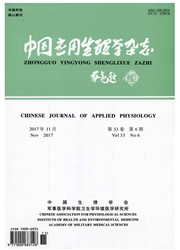

 中文摘要:
中文摘要:
目的:观察应激条件下心肌细胞中神经生长诱导蛋白质-B(NGFI-B)的表达和亚细胞定位的变化,为揭示应激机体心肌损伤的病理学机理提供科学依据。方法:建立心肌细胞应激损伤的离体细胞模型;采用Western blot方法和细胞免疫荧光法观察NGFI-B在应激心肌细胞中的亚细胞定位;采用流式细胞术观察离体心肌细胞的凋亡率;采用Western blot法测定应激心肌细胞中细胞色素C(Cyt C)在胞浆和线粒体中的含量。结果:应激机体心肌细胞线粒体中NGFI-B蛋白含量显著升高,NGFI-B发生向线粒体的转位,促进心肌细胞线粒体Cyt C释放及心肌细胞凋亡;加入核输出抑制剂来普霉素B(LMB)后,NGFI-B的核输出受到阻抑,应激心肌细胞中NGFI-B滞留于胞核,不发生向线粒体的转位,应激心肌细胞中线粒体Cyt C释放及心肌细胞凋亡均受到阻抑。结论:应激诱导心肌细胞中NGFI-B向线粒体转位,并继而活化细胞凋亡的线粒体通路,引起心肌细胞凋亡。
 英文摘要:
英文摘要:
Objective: To investigate the changes of expression and subcellular location of nuclear growth-induced protein-B(NGFI-B) in cardiomyocytes of stressed rats and its biological effect and to provide scientific evidences for exploring the mechanism underlying myocardium injury induced by stress. Methods: The cell model of stress-induced cardiomyocyte injury were established. Western blot method and confocal microscopy method were used to investigate the subcellular location of NGFI-B in cardiomyocytes under stress. The flow-cytometry was selected to detect the apoptotic rate in cardiomyocytes in vitro. Western blot method was used to determine the content of cytochrome C protein in mitochondria and cytoplasm respectively. Results: Stress induced the increase of NGFI-B content in the mitochondria of cardiomyocytes and the translocation of NGFI-B from the nucleus to the mitochondria. The translocation of NGFI-B promoted the release of cytochrome C from the mitochondria and the cardiomyocyte apoptosis. Treatment of stressed cardiomyocytes with leptomycin B, a non-specific blocker of nuclear export, resulted in nuclear retention of NGFI-B and abrogated its ability to induce the release of cytochrome C from the mitochondria. Conclusion: Stress could induce NGFI-B translocafion from the nucleus to the mitochondria in cardiomyocytes, which activated the mitochondrial pathway of cell apoptosis.
 同期刊论文项目
同期刊论文项目
 同项目期刊论文
同项目期刊论文
 期刊信息
期刊信息
